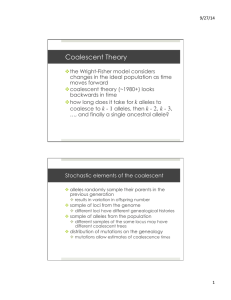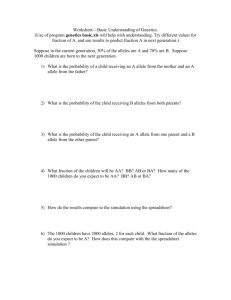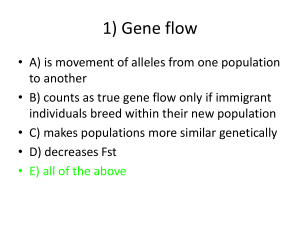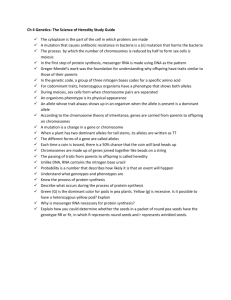Harvard-MIT Division of Health Sciences and Technology
advertisement
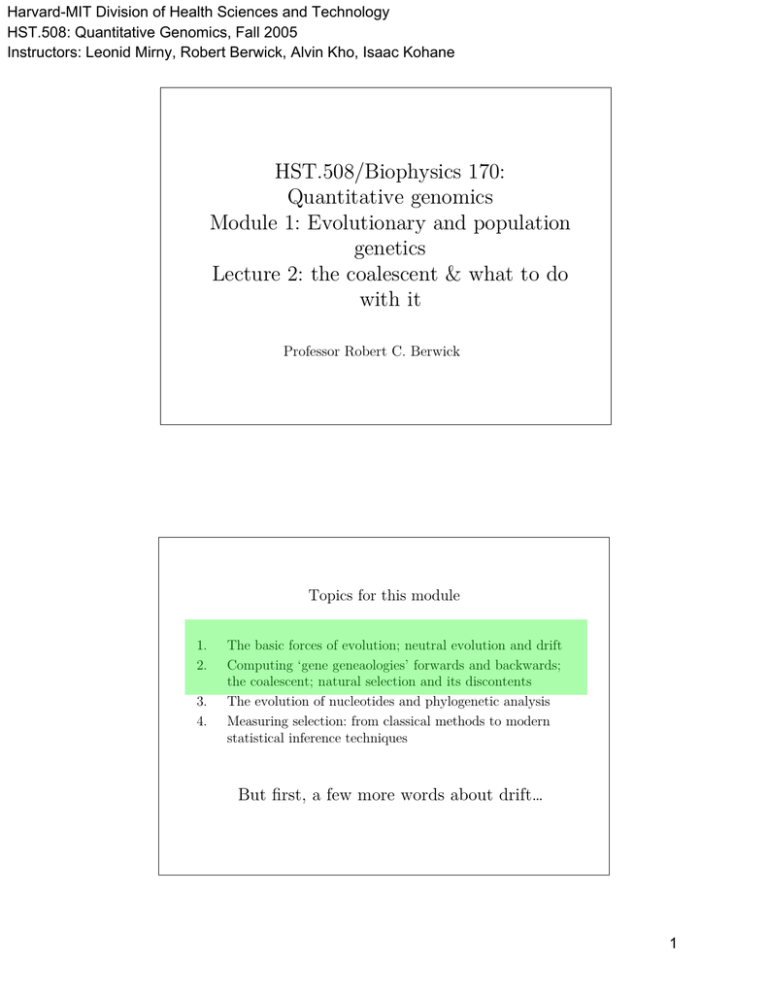
Harvard-MIT Division of Health Sciences and Technology HST.508: Quantitative Genomics, Fall 2005 Instructors: Leonid Mirny, Robert Berwick, Alvin Kho, Isaac Kohane HST.508/Biophysics 170: Quantitative genomics Module 1: Evolutionary and population genetics Lecture 2: the coalescent & what to do with it Professor Robert C. Berwick Topics for this module 1. 2. 3. 4. The basic forces of evolution; neutral evolution and drift Computing ‘gene geneaologies’ forwards and backwards; the coalescent; natural selection and its discontents The evolution of nucleotides and phylogenetic analysis Measuring selection: from classical methods to modern statistical inference techniques But first, a few more words about drift… 1 The key to evolutionary thinking: follow the money; money= variation • We saw how the Fisher-Wright model lets us keep track of variation (= differences, heterozygosity) going forward in time, alternatively, similarity, homozyogosity) • Second we can add in the drip, drip of mutations and see what the account ledger balance says Last Time: The Wright-Fisher model & changes in expected variability We get a binomial tree that depends on frequency, p, and total population size, N. What is the pr that a particular allele has at least 1 copy in the next generation? Well, what is the pr of not picking an allele on one draw? Ans: 1-(1/2N). There are 2N draws (why?). So, pr of not picking for this many draws is [1-(1/2N)]2N = e-1 for large N Let’s explore the consequences… 2 Adding mutations – the mutation-drift balance Mutation gain 2Nu Variation, H Loss at rate 1/(2N) !H = 0 at equillibrium, so Ĥ = 4Nu 1 + 4Nu 4Nu = θ basic level of variation The forces of evolution… Goal: understand relation between forces: u, 1/N signal noise u > ?1 1 N 3 Population “large” wrt genetic drift “Follow the variation” Heterozygosity= Ĥ = 4Nu 1 + 4Nu 4Nu = θ Homozygosity (identity)= 1–H =G= 1/θ These are the key measures of how ‘variant’ two genes (loci), sequences, etc. are What can we learn about their distributions? How can we estimate them from data? How can we use them to test hypotheses about evolution? 4 The F measure already tells us something about expected variation…. G= 1/θ = 1/4Nu= measure that 2 sequences (or alleles, or…) differ in exactly zero ways Compute π = nucleotide diversity = # of diffs in 2 sequences (informally) What is E[π]? We shall see that E[π]= 4Nu ie, θ But why this pattern of variation? Drift? Mutation? Selection? Migration? “Follow the variation”: some famous data about individual variation in Drosophila melanogaster (Marty Kreitman) Table removed due to copyright reasons. Kreitman 1983 original data set for melanogaster Adh sequences Kreitman,M (1983): Nucleotide polymorphism at the alcohol #ehydrogenase locus of Drosophila melanogaster. Nature 304, 412-417. 5 Kreitman data 11 alleles; 14 sites polymorphic 1.8 every 100 sites segregating (typical for Drosophila) Variation in 13 out of 14 silent; position #578 is a replacement polymorphism Q: why this pattern of variation? Q: is 11 alleles a big enough sample? (The answer is Yes, actually, as we shall see) 6 The key to the bookkeeping of evolution is: Follow the money – keeping track of variation Because this is a binomial draw with parameters p, 2N, the mean of this distribution (the expected # of A1 alleles drawn) is just 2Np, i.e., mean frequency is p And its variance is 2Np(1-p) What abour the mean and variance not of the # of alleles, but of the frequency itself, p’ ? E[p']= E[X]/2N = 2Np/2N= p The variance of p' goes down as the population size increases, as we would expect: Var[p' ]= Var[X]2/4N2= 2Np(1–p)/4N2= p(1–p)/2N Key point: drift is important when the variance is large Second consequence: new mutations, if neutral… What is the probability that a particular allele has at least 1 copy in the next generation? In other words: that a brand-new mutation survives? Well, what is the pr of not picking an allele on one draw? Ans: 1-(1/2N). There are 2N draws (why?). So, pr of not picking for this many draws is: [1-(1/2N)]2N = e-1 for large N So: probability of a new mutation being lost simply due to ‘Mendelian bad luck’ is 1/e or 0.3679 Why doesn’t population size N matter? Answer: it’s irrelevant to the # of offspring produced initially by the new gene 7 Climb every mountain? Some surprising results • The power of selection: what is the fixation probability for a new mutation? • If no selection, the pr of loss in a single generation is 1/e or 0.3679 • In particular: suppose new mutation has 1% selection advantage as heterozygote – this is a huge difference • Yet this will have only a 2% chance of ultimate fixation, starting from 1 copy (in a finite population a Poisson # of offspring, mean 1+s/2, the Pr of extinction in a single generation is e-1(1-s/2), e.g., 0.3642 for s= 0.01) • Specifically, to be 99% certain a new mutation will fix, for s= 0.001, we need about 4605 allele copies (independent of population size N !!) • Also very possible for a deleterious mutation to fix, if 2Ns is close to 1 • Why? Intuition: look at the shape of the selection curve – flat at the start, strongest at the middle • To understand this, we’ll have to dig into how variation changes from generation to generation, in finite populations The fate of selected mutations Regime 1: very low copy # Regime 2: Frequency matters 2Ns (compare to Nu factor) 8 Fixation probability of a (neutral) allele is proportional to its initial frequency All variation is ultimately lost, so eventually 1 allele is ancestor of all alleles There are 2N alleles So the chance that any one of them is ancestor of all is 1/2N If there are i copies, the ultimate chance of fixation (removal of all variation) is i/2N (Simple argument because all alleles are equivalent – there is no natural selection) 9 What are we missing? History. The 3 mutations are not independent – increasing sample size n does not have the usual effect of improving accuracy of estimates! (In fact, it’s only marginally effective) ! 1 # 1 & + %1 " ( G " 2uG 2N $ 2N ' 1 & # H = 1 ! G, so H ' " % 1 ! ( H + 2u(1 ! H ) $ 2N ' !H " # 1 H + 2u(1 # H ) 2N !H = 0 at equillibrium, so 4Nu Heterozygosity= Ĥ = (AKA gene diversity) 1 + 4Nu 4Nu = θ basic level of variation 10 The coalescent: The cause of the decline in variation is that all lineages eventually coalesce… Common ancestor Notation: Ti= time to collapse of i genes, sequences,… This stochastic process is called the coalescent 11 Coalescent can be used for… … simulation … hypothesis testing … estimation 12 Looking backwards: the coalescent A coalescent is the lineage of alleles in a sample traced backward in time to their common ancestor allele More useful for inference: we see a certain pattern of data, want to understand the processes that produced that data NB, we cannot actually know the coalescent (but who cares?) Provides intuition on patterns of variation Provides analytical solutions Key: We need only model genealogy of samples: we don’t need to worry about parts of population that did not leave descendants (as long as mutations are neutral) 13 What is time to most recent common ancestor? (MRCA)? Notation: Ti= time to collapse of i genes, sequences,… In other words… On average, depth 2N before collapse to 1 ancestor Can we prove this and use it? If it’s true, then we can use this to get expected sequence diversity, estimates of # of segregating sites, heterozygosity, and much, much more… 14 Pr that two genes differ (ie, H as before…) H= P(mutation) 2u 4Nu = = P(mutation)+P(coalescence) 2u + 1 4Nu + 1 2N Q: where did 2u come from? For example, if u= 10-6, then in a population of 106, mean heterozygosity expected is 0.8 This is a lot easier to compute than before!!! We superimpose (neutral) mutations on top of a ‘stochastic’ genealogy tree This product is our θ Can we estimate it? Note that each mutation in a coalescent lineage produces a distinct segregating site (Why?) Why can we superimpose these 2 stochastic effects? Because mutations don’t affect reproduction (population size) 15 Basic idea • More parents, slower rate to coalesce • Neutral mutations don’t affect reproduction (N) so can be superimposed afterwards on the gene tree Now we can get the basic ‘infinite site’ result for expected # diffs in DNA seqs: 16 Expected time to coalescence Using the coalescent as a ‘history model,’ expectations can be derived either in a discrete time model (Fisher-Wright) or in a continuous time model The discrete model yields a ‘geometric’ probability distribution The continuous time model yields an ‘exponential’ probability distribution of ‘waiting times’ until each coalescence 17 An example coalescent for four alleles # branches 0 T4 4 T3 t1 3 t2 t3 T2 2 1 t1 t2 t3 Generation time t, measured backwards Total time in coalescent TC = 4t1 + 3(t2–t1) + 2(t3–t2)= 4T4 + 3T3+ 2T2 # of expected mutations is uTC What is the expected value of TC? Discrete time argument to find expected coalescent time, for n alleles Allele 1 has ancestor in 1st ancestral generation Allele 2 will be different from 1 with probability 1–1/2N=(2N–1)/2N Allele 3 will be different from first 2, assuming alleles 1 and 2 are distinct, with probability: (2N–2)/2N So total probability that the first three alleles do not share an ancestor is: (2N–1)/2N x (2N–2)/2N Probability all n alleles do not share an ancestor (no coalescence) is (dropping N-2 and higher terms): (1 ! 1 2 n !1 1 2 n !1 )(1 ! )!(1 ! ) "1! ! !! 2N 2N 2N 2N 2N 2N 18 1 2 n "1 " "! ; 2N 2N 2N Pr coalescence in any particular generation 1 + 2 + ! + (n " 1) n(n " 1) ! = 2N 4N Pr no coalescence ! 1 " So: Time to 1st coalescence is geometrically distributed with pr success of n(n–1)/4N Mean of geometric distribution, is this reciprocal of success: E[Tn]= 4N/n(n–1) So, E[T2]= 4N/2 = 2N E[Ti]= 4N/i(i–1) (coalescence time from i alleles to i-1) Note: we do not really care about the trees – they are a ‘nuisance’ parameter Here’s another way to look at it: when there are 4 alleles, we have to pick 2 of them to ‘coalesce’ or merge… so there are 4 choose 2 ways of doing this, out of 2N possible alleles. This gives the Pr of Coalescent event, as follows. The time to the next Coalescent Event is the reciprocal of this number, since this distribution is geometric (a standard result), so: 19 Note typical shape and amount of time at tips of tree! 2N ! 3$ #" 2 &% Shorter waiting time because only 3 choose 2 genes/sequences could ‘collide’ 2N ! 2$ #" 2 &% Longer waiting time because only 2 genes/sequences left to ‘collide’ Rescaling time in terms of generational units 2N=1 time unit 20 Rescaling time in terms of generational units 1/3 clock tick 2N=1 clock tick Now we can actually get some results…! Total time in all branches of a coalescent is: n TC = ! iTi i=2 i is just the # of ‘mergers’, ie 1 less than # of alleles at tips So expected Total time in all branches is: n n 1 i=2 i " 1 E[TC ] = ! iE[Ti ] = 4N ! i=2 Expected # segregating sites is neutral mutation rate, u times the expected time in coalescent, therefore: n 1 i=2 i " 1 E[SN ] = uE[TC ] = ! # ! != Sn 1 1 1 1+ + +"+ 2 3 n "1 21 Application to our example coalescent for four alleles # branches 0 T4 4 T3 t1 3 T2 t2 2 1 t3 t1 t2 t3 Generation time t, measured backwards n 1 i=2 i ! 1 E[TC ] = 4N " Total time TC = 4N(1+1/2+1/3)=44N/6 # of expected mutations is uTC or θ(11/6) or 1.83 θ in a sample of 4 alleles, which is also the expected # of segregating sites Application to Kreitman SNP data # segregating sites: 14 Sample size: n=11 ! != Sn = 11 = 4.78 (4Nu) for locus 2.93 1 1 1 + +"+ 2 3 n "1 ! 4.78 ! for nucleotide site= = 0.0062 768 1+ What about sample size question? Well, note: n n 1 1 E[SN ] = ! # , and # $ ln(n), i=2 i " 1 i =1 i so # segregating sites increases with log of sample size 22 Another estimator for theta Use E[π], # pairwise differences between 2 sequences (In a sample of size n, there are n(n–1) pairwise comparisons.) This is 2uE[t], where E[t] is mean time back to common ancestor of a random pair of alleles, i.e., 2N, so E[π]=θ Let’s apply this to an actual example, to see how π and θ might be used… 23 Example – control region of human mtDNA The key question (as usual): Why the differences between these two supposedly equivalent estimates?? ?? Sampling error?? ?? Natural selection?? In fact, we can use the difference between these estimators to test for this (Tajima’s D) ?? Variation in population size/demographics?? We’ve assumed constant N. Need to incorporate changing N, migration, etc. ?? Failure of mutation model?? We’ve assumed mutation never strikes the same nt position twice 24 Q: How do we get sampling error? A: coalescent simulation How you do a coalescent simulation 25 Now we could use this spectrum to test our hypotheses about the model assumptions we made 26 Intuition behind the continuous time model: life-span of a cup Intuition: if pr breaking is h per day, and expected life-span is T days; show that T is 1/h (= 1/2N) Same as ‘coalesence’ between 2 genes Cup either breaks 1st day w/ pr h or doesn’t with pr 1–h; gene either coalesces or doesn’t. If it breaks 1st day, mean life-span is 1 For surviving cups, life-span doesn’t depend on how old it is, so if a cup has already lived a day, expected life-span is now 1+T. So: T= h + (1–h)(1+T)= 1/h 27 A bit more formally… PC = 1 2N PNC = 1 ! 1 2N 1 % " PNC for t generations: (PNC )t = $ 1 ! ' # 2N & t PNC for t generations and then coalescing in t + 1 : t 1 % 1 " $# 1 ! ' 2N & 2N Continuous time If 2N large, > 100, use Taylor series expansion for e : ! 12 N ( ) " 1 ! 1 2N so 1 ! 2tN P C,t +1 = e 2N e exponential distribution for large t, so P[x] = 1 b ie! xb with mean b, variance b 2 28 Sum all of these expectation bars… Summary: the coalescent models the geneology of a sample of n individuals as a random bifurcating tree The n-1 coalescent times T(n), T(n-1), …, T(1) are mutually independent, exponentially distributed random variables Rate of coalescence for two lineages is (scaled) at 1 Total rate, for k lineages is ‘k choose 2’ Basic references: 29 Summary equations Extensions • Add migration • Population size fluxes (‘bottlenecks’) • Estimation methods – based on likelihoods 30 Let’s deal with population size issue: effective population size Suppose population size fluctuates. For instance, in one generation, population size is N1 with probability r, the next it is N2 with probability 1–r Can we patch up the formula? General answer: Yes, we replace N with Ne – the effective population size Let’s see what this means in flutating population size case We replace Var[ p(1 ! p)] Var[ p(1 ! p)] with 2N 2N e 31 Effective population size must be used to ‘patch’ the Wright-Fisher model Variance for N1 is p(1–p)/2N1 with probability r Variance for N2 is p(1–p)/2N2 with probability 1–r Average these 2 populations together, to get mean variance, ‘solve’ for Ne " r 1! r% Var[ p '] = p(1 ! p) $ + or 2N # 1 2N 2 '& Ne = 1 1 1 r + (1 ! r) N1 N2 i.e., the harmonic mean of the population sizes (the reciprocal of the average of the reciprocals) Always smaller than the mean Much more sensitive to small numbers 32 Effective population size & bottlenecks Example: if population size is 1000 w/ pr 0.9 and 100 w/ pr 0.1, arithmetic mean is 901, but the harmonic mean is (0.9 x 1/1000 + 0.1 x 1/10)-1 = 91.4, an order of magnitude less! Thus, if we have a population (like humans, cheetahs) going through a ‘squeeze’, this changes the population sizes, hence θ Suppose we have an arbitrary distribution of offspring numbers? Fluctuating population size •Suppose population sizes: 11, 21, 1000, 21, 4000, 45, 6000, 12 •Arithmetic Mean (11+21+1000+21+4000+45+6000+12)/8 = 1389 •Harmonic Mean = 27 •Harmonic Mean is smaller (small values have more important effects!) 33 Different #s males and females Changing population sizes: the effective population size, Ne Varying offspring #, breeding success, overlapping generations… 34 Where’s Waldo???? Darwin???? 35


